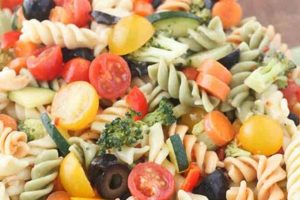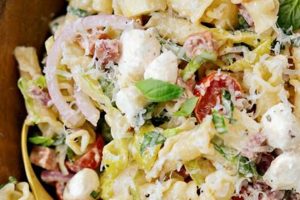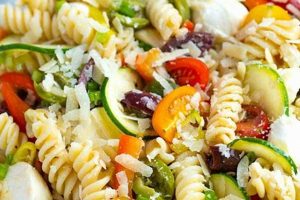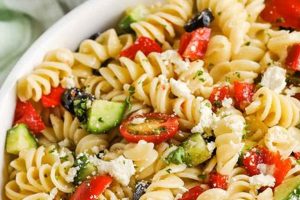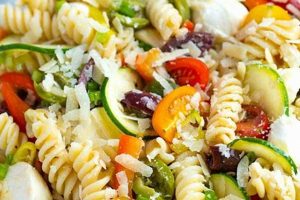Dishes combining cooked pasta, flaked salmon, and various other ingredients like vegetables, herbs, and a flavorful dressing constitute a popular and versatile meal option. These dishes can range from light and refreshing summer salads to more robust and hearty meals, depending on the chosen ingredients and preparation methods. For example, a simple version might include cooked rotini pasta, canned salmon, chopped celery, red onion, and a mayonnaise-based dressing. More elaborate variations could incorporate grilled or pan-fried fresh salmon fillets, different pasta shapes, a wider array of vegetables, and a vinaigrette dressing.
Such culinary creations offer a nutritious and convenient way to enjoy the health benefits of both salmon, rich in omega-3 fatty acids and protein, and pasta, a good source of carbohydrates. The flexibility of these dishes allows for customization based on dietary preferences and seasonal availability of ingredients. Historically, combining fish with grains and other ingredients can be traced back to various cultures around the Mediterranean and beyond, demonstrating a longstanding appreciation for this type of balanced meal.
This article will explore various aspects of preparing these dishes, including selecting the appropriate type of salmon and pasta, choosing complementary ingredients, crafting delicious dressings, and providing helpful tips for achieving optimal flavor and texture.
Tips for Creating Delicious Salmon and Pasta Salads
Achieving a well-balanced and flavorful dish requires careful consideration of several key factors. The following tips offer guidance for preparing successful and satisfying meals.
Tip 1: Salmon Selection and Preparation: Opting for high-quality salmon, whether canned, frozen, or fresh, significantly impacts the final result. Fresh salmon fillets can be grilled, pan-fried, or baked before flaking. Canned salmon should be drained and any skin and bones removed. Frozen salmon should be thawed completely before incorporating it into the salad.
Tip 2: Pasta Choices: Short, sturdy pasta shapes like rotini, penne, or farfalle hold their shape well and pair effectively with other ingredients. Cook pasta al dente to maintain texture and prevent a mushy salad.
Tip 3: Complementary Ingredients: A wide range of vegetables, herbs, and other additions can enhance the flavor profile. Consider incorporating ingredients such as chopped cucumbers, bell peppers, red onion, cherry tomatoes, fresh dill, parsley, or capers.
Tip 4: Dressing Selection: The dressing ties the salad together and contributes significantly to the overall taste. Options include creamy mayonnaise-based dressings, lighter vinaigrettes, or lemon-herb dressings. The dressing should complement both the salmon and other chosen ingredients.
Tip 5: Flavor Balancing: Achieving a harmonious balance of flavors is crucial. Consider the acidity of the dressing, the saltiness of the salmon, and the sweetness or bitterness of any vegetables. Taste and adjust seasonings as needed.
Tip 6: Chilling and Serving: Chilling the salad for at least 30 minutes before serving allows the flavors to meld and enhances the refreshing quality of the dish. Serve chilled for optimal enjoyment.
Tip 7: Preventing Sogginess: To prevent the salad from becoming soggy, ensure the pasta is well-drained and avoid overdressing. Adding the dressing shortly before serving can also help maintain texture.
By following these tips, one can consistently create flavorful and satisfying dishes suitable for various occasions, from casual lunches to more formal gatherings.
This exploration of tips provides a solid foundation for crafting successful dishes. The following section will delve into specific recipe variations, offering further inspiration and practical guidance.
1. High-quality Salmon
High-quality salmon plays a pivotal role in determining the overall success of salmon and pasta salad recipes. The salmon’s flavor, texture, and freshness directly impact the final dish. Superior-quality salmon offers a richer, cleaner taste, free from off-flavors that can detract from the other ingredients. Its firm, flaky texture holds up well when mixed with pasta and other components, preventing a mushy or unappetizing consistency. Freshness ensures optimal nutritional value and contributes to a more vibrant and appealing salad. For instance, using wild-caught Alaskan salmon, known for its robust flavor and firm texture, elevates the dish compared to using canned salmon of lower quality, which might exhibit a softer texture and a more pronounced fishy odor.
Furthermore, the choice of salmon preparation method also influences the final outcome. Grilling or pan-searing high-quality salmon fillets imparts a smoky char and enhances their natural flavors, creating a more complex and satisfying salad. In contrast, using pre-cooked or canned salmon offers convenience but may lack the nuanced flavors achieved through fresh preparation. Consider a salad featuring grilled sockeye salmon with its distinct reddish-orange color and rich flavor profile. This adds visual appeal and a depth of flavor that canned salmon, even high-quality varieties, may not replicate. Utilizing high-quality salmon allows for greater flexibility in recipe development, enabling more complex flavor combinations and textures.
In conclusion, prioritizing high-quality salmon significantly elevates salmon and pasta salad recipes. The inherent flavor, texture, and freshness of the salmon enhance the overall sensory experience, contributing to a more satisfying and enjoyable meal. While cost considerations might tempt one towards less expensive options, the noticeable difference in taste and texture underscores the importance of investing in superior-quality salmon for optimal results. Recognizing the crucial role of salmon quality allows for informed decisions during ingredient selection and preparation, paving the way for a truly exceptional culinary experience.
2. Appropriate Pasta Shape
Pasta selection significantly influences the overall success of salmon and pasta salad recipes. The pasta’s shape, size, and texture interact with the other ingredients, affecting the dish’s visual appeal, ease of consumption, and flavor distribution. Choosing an appropriate pasta shape ensures a harmonious balance between the salmon, vegetables, dressing, and other components, creating a cohesive and enjoyable culinary experience.
- Shape and Texture Harmony
Certain pasta shapes pair more effectively with flaked or cubed salmon. Short, tubular shapes like penne, rotini, or fusilli hold the salmon pieces and dressing well, ensuring even distribution throughout the salad. Their ridges and curves also create textural interest. Conversely, long, thin pasta like spaghetti or linguine, while delicious in other contexts, can become unwieldy and difficult to manage in a salad setting, making it harder to achieve a balanced bite.
- Size and Proportion
The pasta’s size should be proportionate to the salmon pieces and other ingredients. Overly large pasta can overwhelm the delicate flavors of the salmon and vegetables, while excessively small pasta might get lost amongst the other components. Medium-sized pasta shapes generally offer the best balance, ensuring that each bite contains a pleasing combination of all the elements. For example, using farfalle (bowtie pasta) provides visual appeal and readily captures the dressing and other ingredients.
- Cooking Method and Consistency
Cooking the pasta al dente, or slightly firm to the bite, is crucial for preventing a mushy salad. Overcooked pasta tends to absorb too much dressing and break down, resulting in a less appealing texture. Maintaining the pasta’s structural integrity ensures a pleasant chewiness and prevents the salad from becoming overly soft or soggy. This is particularly important when incorporating heavier, cream-based dressings.
- Visual Appeal and Presentation
The visual appeal of the pasta contributes to the overall presentation of the salad. Shapes with interesting textures and contours, like radiatore or cavatappi, can add visual interest and enhance the dining experience. Additionally, the pasta’s color can complement the other ingredients, creating a more visually appealing dish. For example, tri-color rotini can add a pop of color and visual interest.
Careful consideration of pasta shape enhances the balance and enjoyment of salmon and pasta salads. Selecting pasta that complements the salmon, vegetables, and dressing creates a cohesive culinary experience. The appropriate pasta shape not only improves the texture and flavor distribution but also enhances the visual appeal, contributing to a more satisfying and enjoyable meal. By understanding the interplay between these elements, one can elevate simple salmon and pasta salads into truly delightful culinary creations.
3. Complementary Ingredients
Complementary ingredients play a crucial role in elevating salmon and pasta salad recipes from simple to exceptional. These additions contribute not only to flavor complexity but also to textural variety, nutritional value, and visual appeal. A thoughtful selection of complementary ingredients can transform a basic pasta and salmon combination into a vibrant and satisfying meal. The following facets explore the essential considerations for selecting complementary ingredients that harmonize with the core components of salmon and pasta.
- Fresh Vegetables:
Fresh vegetables provide textural contrast, vibrant color, and essential nutrients. Crisp cucumbers, juicy cherry tomatoes, and crunchy bell peppers offer a refreshing counterpoint to the richness of the salmon and the density of the pasta. These additions introduce a variety of flavors and contribute to a more balanced and satisfying meal. For example, the slight bitterness of blanched asparagus can offset the richness of the salmon, while the sweetness of roasted red peppers complements the savory notes of the dish. The choice of vegetables can also reflect seasonal availability, further enhancing the freshness and flavor of the salad.
- Herbs and Aromatics:
Fresh herbs and aromatics contribute significantly to the flavor profile of the salad. Dill, parsley, chives, and mint offer bright, herbaceous notes that complement the salmon’s flavor. Aromatics like red onion or shallots add a pungent depth, while garlic or ginger can introduce a subtle warmth or spiciness. The careful selection and balance of these ingredients can elevate the overall flavor profile, creating a more complex and nuanced dish. For instance, fresh dill pairs particularly well with salmon, while a hint of mint can add a refreshing twist.
- Textural Elements:
Incorporating ingredients that provide textural contrast enhances the sensory experience of the salad. Toasted nuts or seeds, such as slivered almonds, sunflower seeds, or toasted pine nuts, introduce a satisfying crunch. Crumbled feta cheese or goat cheese can add a creamy tang, while Kalamata olives offer a briny, chewy element. These additions prevent the salad from becoming monotonous and create a more dynamic and enjoyable culinary experience.
- Acidic Components:
A touch of acidity brightens the flavors of the salad and balances the richness of the salmon. A squeeze of lemon juice, a splash of red wine vinegar, or the addition of capers introduces a tartness that cuts through the fattiness of the fish and enhances the other flavors. This acidic element plays a crucial role in preventing the salad from feeling heavy or overly rich. For example, a lemon-dill dressing can provide both acidity and herbaceousness, complementing the salmon beautifully.
The careful selection and integration of complementary ingredients elevates salmon and pasta salad recipes from simple to extraordinary. By considering the interplay of flavors, textures, colors, and nutritional value, one can create a well-balanced and satisfying meal that showcases the versatility and deliciousness of this classic combination. The choice of complementary ingredients can also be tailored to individual preferences and dietary needs, making salmon and pasta salad a highly adaptable and enjoyable dish for various occasions.
4. Flavorful Dressing
Flavorful dressing forms an integral component of successful salmon and pasta salad recipes, acting as a unifying element that binds the diverse ingredients and elevates the overall sensory experience. The dressing’s role extends beyond simply adding moisture; it contributes significantly to the dish’s flavor profile, texture, and visual appeal. A well-chosen dressing enhances the inherent flavors of the salmon and other components while also adding its own distinct character. The interplay between the dressing and the other ingredients creates a synergistic effect, resulting in a more complex and satisfying culinary experience.
The specific type of dressing employed significantly impacts the final character of the salad. A creamy dill dressing, for example, complements the richness of the salmon and adds a bright, herbaceous note. A lemon-vinaigrette, on the other hand, offers a lighter, more acidic counterpoint, cutting through the fattiness of the fish and enhancing the flavors of the vegetables. Aioli-based dressings provide a garlicky richness, while pesto dressings introduce an herbaceous and nutty dimension. The choice of dressing should consider the other ingredients and the desired overall flavor profile. For a Mediterranean-inspired salad with salmon, feta, and olives, a lemon-herb vinaigrette provides a fitting complement. In contrast, a salad featuring smoked salmon, capers, and red onion might benefit from a creamy dill dressing.
The quality of ingredients within the dressing also plays a crucial role. Freshly squeezed lemon juice provides a brighter, more vibrant acidity compared to bottled lemon juice. High-quality olive oil adds a depth of flavor and a smooth texture. Fresh herbs, rather than dried, offer a more intense aroma and flavor. Attention to these details elevates the dressing and, consequently, the entire salad. Furthermore, the emulsification process, whether for a vinaigrette or a creamy dressing, significantly impacts the texture and stability. A properly emulsified dressing clings evenly to the pasta and other ingredients, ensuring a consistent flavor experience in each bite. Understanding the crucial role of flavorful dressing enables informed decision-making during recipe development and preparation, paving the way for truly exceptional salmon and pasta salad creations.
5. Proper Chilling
Proper chilling constitutes a crucial step in preparing salmon and pasta salad recipes, significantly influencing food safety, flavor development, and overall textural quality. Chilling allows the flavors of the various componentssalmon, pasta, vegetables, and dressingto meld and harmonize, creating a more cohesive and balanced flavor profile. Furthermore, proper chilling ensures the safety of the dish by inhibiting bacterial growth and maintaining the freshness of the ingredients. The following facets explore the critical aspects of proper chilling and its impact on salmon and pasta salad.
- Food Safety:
Chilling cooked salmon and pasta promptly to a safe temperature below 40F (4C) inhibits the rapid growth of harmful bacteria. This is particularly important for dishes containing mayonnaise-based dressings, which can provide an ideal environment for bacterial proliferation. Maintaining a safe temperature throughout the preparation and storage process minimizes the risk of foodborne illness. Leaving a salmon pasta salad at room temperature for an extended period, especially in warmer climates, significantly increases the risk of bacterial contamination.
- Flavor Enhancement:
Chilling allows the flavors of the individual ingredients to meld and mature. The absorption of the dressing by the pasta and other components deepens the flavor profile and creates a more harmonious blend. This chilling period allows the subtle nuances of the herbs, spices, and other aromatics to permeate the dish, resulting in a more complex and satisfying taste experience. For example, a lemon-herb dressing will infuse the salmon and pasta more thoroughly after a period of chilling.
- Texture Optimization:
Chilling firms the pasta and other ingredients, enhancing the overall textural quality of the salad. This is especially important for salads containing more delicate vegetables, such as leafy greens or cucumbers, which can become wilted or soggy if not chilled properly. The chilling process also helps to stabilize creamy dressings, preventing them from separating or becoming too thin. A chilled salad presents a more appealing and palatable texture compared to a room-temperature salad.
- Presentation and Serving:
A properly chilled salad presents a more refreshing and appealing dish. The cooler temperature enhances the flavors and textures, creating a more enjoyable dining experience, particularly during warmer months. Serving the salad chilled also helps to maintain its structural integrity, preventing the ingredients from becoming overly soft or wilted. A visually appealing and refreshing salad enhances the overall dining experience.
Proper chilling elevates salmon and pasta salad recipes from merely palatable to truly enjoyable culinary experiences. Attention to food safety, flavor development, and texture optimization through proper chilling techniques results in a safer, more flavorful, and visually appealing dish. By understanding and implementing these chilling principles, one can consistently create high-quality salmon and pasta salads that satisfy both the palate and the eye.
Frequently Asked Questions
This section addresses common inquiries regarding the preparation and enjoyment of salmon and pasta salads. Clarity on these points facilitates successful culinary endeavors and enhances appreciation for this versatile dish.
Question 1: What type of salmon is best suited for pasta salad?
Canned, frozen, or fresh salmon can be utilized. Fresh, high-quality salmon fillets offer optimal flavor and texture. If using canned salmon, opt for varieties packed in water or olive oil, draining the liquid thoroughly before incorporating. Frozen salmon should be fully thawed and any excess moisture patted away.
Question 2: Can the pasta be cooked in advance?
Pasta can be cooked ahead of time. After cooking, rinse the pasta under cold water to stop the cooking process and prevent sticking. Drain thoroughly and store in an airtight container in the refrigerator until ready to use.
Question 3: How long can salmon pasta salad be stored?
Properly stored in an airtight container in the refrigerator, salmon pasta salad typically lasts for three to four days. Monitor for any signs of spoilage, such as off-odors or changes in texture, before consuming.
Question 4: What are some suitable vegetarian alternatives to salmon?
Individuals seeking vegetarian options can substitute grilled halloumi, pan-fried tofu, or chickpeas for salmon. These alternatives provide protein and complement the pasta and other ingredients.
Question 5: How can one prevent the pasta salad from becoming soggy?
To prevent sogginess, ensure the pasta is cooked al dente and well-drained. Adding the dressing shortly before serving also helps maintain the desired texture. Avoid overdressing the salad.
Question 6: Can different types of pasta be used?
While various pasta shapes can be used, sturdy, short pasta such as rotini, penne, or farfalle generally work best. These shapes hold their form well and capture the dressing effectively. Avoid long, thin pasta like spaghetti, which can become unwieldy in a salad.
Addressing these common questions provides a comprehensive understanding of various aspects related to salmon and pasta salad preparation and consumption. This knowledge empowers individuals to confidently create and enjoy this versatile and delicious dish.
The subsequent section will offer a curated selection of specific salmon and pasta salad recipes, providing practical guidance and culinary inspiration.
Salmon and Pasta Salad Recipes
This exploration of salmon and pasta salad recipes has provided a comprehensive overview of key elements contributing to successful dish preparation. From the importance of high-quality salmon selection and appropriate pasta choices to the thoughtful integration of complementary ingredients and the creation of flavorful dressings, each component plays a crucial role in achieving a balanced and satisfying culinary experience. Proper chilling techniques further enhance food safety, flavor development, and textural quality. Addressing frequently asked questions provides practical guidance and clarity on common concerns, empowering culinary endeavors.
The versatility inherent in these recipes allows for endless customization and adaptation to individual preferences and dietary needs. Exploration of diverse flavor profiles, textures, and presentations offers a continuous opportunity for culinary creativity and innovation. One can anticipate continued evolution and refinement of these recipes as culinary practices adapt to emerging trends and ingredient availability. Ultimately, a well-crafted salmon and pasta salad offers a nutritious, flavorful, and convenient meal option suitable for various occasions.

